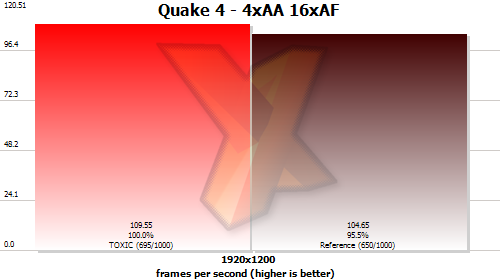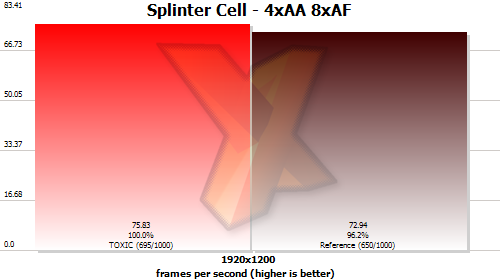Testing and Early Thoughts
Performance



Our tests show the core increase buys you a few more frames per second in each case, to the tune of between ~2% and ~5%. Depending on game and settings, you'll (obviously) see anywhere between 0 and ~7% increase in framerates, everything else being equal.
Noise
Sadly, at the lowest fan speed setting, we found the TOXIC to make at least as much noise than ATI's new reference cooler for Radeon X1950 XTX, and certainly more at the higher fan speed they suggest you use when running at TOXIC clocks (activated by a software utility as it stands, which currently only works for the first board it finds on your system in CrossFire mode).Thoughts
Our early thoughts aren't that positive. At £324.95 + VAT (for either version), you're essentially paying £ for a new cooler and a guaranteed 45MHz over stock clocks. When the cooler is no quieter (and usually more noisy) than the one it replaces and can potentially take up one more slot, it's hard to justify. You get a bundled game and some media software, but then you get a bundled game and media software with other sub-£300 X1950 XTX examples from other vendors.While overclocking past TOXIC-mode clocks might show the Sapphire's advantage, testing which we'll complete in short order, we think you currently stand much better off saving £80 and getting a regular one and trying for 695MHz core (or more) yourself, which is essentially what you're doing anyway. There's no large advantage to the TOXIC cooler over the well-sorted X1950 XTX reference cooler (unless overclocking both proves otherwise), and in this case all we see is a myriad minor disadvatanges that add up to something that isn't currently appealing.
On the upside, though, the TOXIC Radeon X1950 XTX card is the fastest ATI card currently available. You pays your money and you makes your choice. Our advice right now? The extra performance is nice, sure, but we'd like to see even higher clocks for a liquid-cooled card and a slight design rejig before handing out recommendations.
We'll flesh out our full opinions in the full review which'll encompass some testing in CrossFire mode and further-than-TOXIC overclocking, but currently the TOXIC as an alternative to a reference-style example isn't the stellar product that it could be. Look out for the full analysis in due course.













